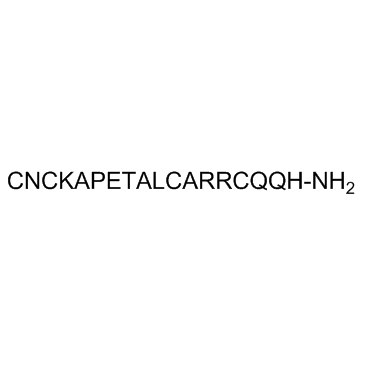24345-16-2
| Name | Apamin |
|---|---|
| Synonyms |
apamine
MFCD00167944 N-{[(1R,4S,7S,13S,16S,19S,22S,25S,28R,31S,34S,37S,40R,47S,50R)-50-Amino-4-(4-aminobutyl)-47-(2-amino-2-oxoethyl)-34,37-bis(3-carbamimidamidopropyl)-16-(2-carboxyethyl)-19-(1-hydroxyethyl)-25-isobut yl-7,22,31-trimethyl-2,5,8,14,17,20,23,26,29,32,35,38,46,49-tetradecaoxo-42,43,52,53-tetrathia-3,6,9,15,18,21,24,27,30,33,36,39,45,48-tetradecaazatricyclo[26.16.10.0]tetrapentacont-40-yl]carbony ;l}-L-glutaminyl-L-glutaminyl-L-histidinamide Apamin APAMIN,BEE VENOM APAMIN FROM BEE VENOM CNCKAPETALCARRCQQH-NH2 M.W. 2027.34 C79H131N31O24S4 APAMIN FROM HONEY BEE VENOM EINECS 246-182-7 |
| Description | Apamin, an 18 amino acid peptide neurotoxin found in apitoxin (bee venom), is known to block Ca2+-activated K+ channels and prevent carbon tetrachloride-induced liver fibrosis. |
|---|---|
| Related Catalog | |
| Target |
K+ channel[1] |
| In Vitro | Apamin is an 18 amino acid peptide neurotoxin found in apitoxin (bee venom). It has long been known as a specifically selective blocker of Ca2+-activated K+ (SK) channels. Apamin inhibits liver fibrosis in a 3,5-diethoxycarbonyl-1,4-dihydrocollidine (DDC)-induced mouse model as determined by hematoxylin and eosin staining. Apamin treatment attenuates inflammatory cytokine expression, including IL-6, IFN-γ, TNF-α and IL-1β compared with expression levels in the DDC-fed group[1]. Apamin is an 18 amino acid peptide neurotoxin found in apitoxin (bee venom). Apamin, a neurotoxin extracted from bee venom, specifically binds to a particular class of Ca2+-activated K+ channels which are involved in the slow afterhyperpolarization (S-AHP) that follows action potentials in many excitable cell[2]. |
| In Vivo | To investigate the anti-fibrotic effect of Apamin on ECM deposition in the DDC-fed mice, Liver fibrosis induced by DDC is confirmed by induction of fibrogenic genes, FSP-1, α-smooth muscle actin (α-SMA) and collagen I expression. Expression of α-SMA is strongly expressed in the myofibroblasts and HSCs around the proliferated bile duct in the DDC-fed group and clearly with the Apamin treatment. Moreover, expression of collagen I in the DDC-fed group is significantly increased, especially in the portal tracts[1]. |
| Cell Assay | HSC-T6 cells, an immortalized rat hepatic stellate cell line, which has a stable phenotype and biochemical characteristics. Cells are cultured at 37°C in a humidified incubator under a 5% CO2 atmosphere. HSC-T6 cells are seeded in complete medium for 24 h. The cells are changed to fresh serum-free media containing the indicated concentrations of Apamin (0.5, 1 and 2 µg/mL). After 24 h, the cells are replaced with fresh serum-free media containing 2 ng/mL of TGF-β1 for 24 h[1]. |
| Animal Admin | Mice[1] For induction of liver injury, 8-week-old C57BL/6 male mice (20-25 g) are selected. Male C57BL/6 mice are fed a control diet or a DDC supplemented diet (0.1%) for 4 weeks to induce advanced biliary fibrosis. The mice receive an intraperitoneal injection of Apamin (0.1 mg/kg) dissolved in saline twice a week. Mice are sacrificed after 4 weeks from the first DDC diet administration. |
| References |
| Density | 1.6±0.1 g/cm3 |
|---|---|
| Molecular Formula | C79H131N31O24S4 |
| Molecular Weight | 2027.339 |
| Exact Mass | 2025.886597 |
| PSA | 1021.52000 |
| LogP | -14.24 |
| Index of Refraction | 1.724 |
CHEMICAL IDENTIFICATION
HEALTH HAZARD DATAACUTE TOXICITY DATA
|
| Symbol |

GHS08 |
|---|---|
| Signal Word | Danger |
| Hazard Statements | H334 |
| Precautionary Statements | P261-P342 + P311 |
| Hazard Codes | Xn |
| Safety Phrases | S22-S24/25 |
| RIDADR | UN 2811 |
| WGK Germany | 3 |
| RTECS | CD6899900 |
| Packaging Group | III |
| Hazard Class | 6.1(b) |


